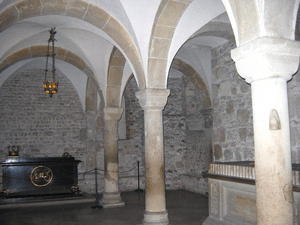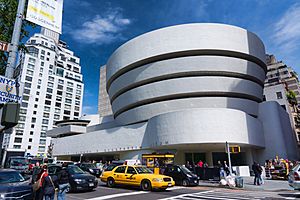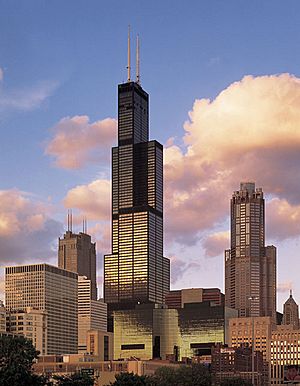Architecture facts for kids
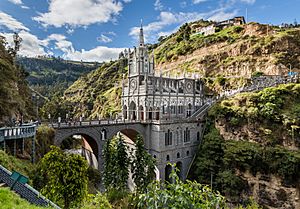
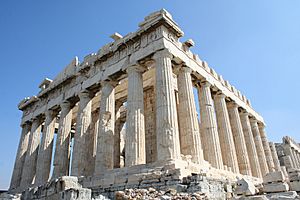
Architecture is all about designing and building structures. These can be anything from houses and churches to big office buildings. It's also the job of an architect, who is a professional designer.
To become an architect, you need to study at a university. Architecture can involve small projects, like designing a garage. It can also be about huge projects, like planning a whole city. Architects often work closely with civil engineers, who design things like roads and bridges.
Contents
History of Architecture
Long ago, people built simple huts and wooden houses. These protected them from the weather. For safety, these early homes were often built close together.
Great civilizations, like the Ancient Egyptians, built huge temples and structures. A famous example is the Great Pyramids of Giza. The Ancient Greeks and Romans created what we call "Classical Architecture."
The Romans, over 2000 years ago, learned about the arch from the Etruscans. The Etruscans had learned it from the Mesopotamians. Stone columns, which still support many important buildings like the Parthenon in Athens, were first copied from early wooden posts.
Classical Architecture

Classical Architecture followed strict rules. It used symmetry, which means everything was balanced. It also used proportion, meaning shapes were kept in certain ways.
One important rule was the Golden Mean. Simply put, if you were designing a room, the long side would be about 1.6 times longer than the short side. This made the design look pleasing. These rules came from thousands of years of experience. They are still useful today.
In other parts of the world, like India, architecture is known for its detailed carvings on temples and palaces. Different styles also developed in China, Japan, Southeast Asia, Africa, Mexico, and Central and South America.
Medieval and Renaissance Architecture
Later, in Western Europe, during the Middle Ages, people developed new styles. These included Romanesque architecture and then Gothic architecture. Gothic buildings are known for their tall, pointed windows and arches. Many churches were built in the Gothic style. Castles were also common during this time. In Eastern Europe, churches often featured domes. People added their own ideas and decoration to the older Classical styles. The Renaissance period then brought back many classical ideas.
Modern Architecture
In the late 1700s, the Industrial Revolution began. This led to new machines that could make things quickly and cheaply. Many factories and mills were built during this time.
Even decades later, in the Victorian era, architects still used the Gothic style for new churches. For a long time, buildings were limited in size by the strength of wood and masonry (stone or brick). Gothic cathedrals were very large because their arches and buttresses allowed stone buildings to be built taller. For example, the cathedral in Ulm, Germany, is over 500 feet tall. However, building with stone had its limits. Trying to build too tall could cause a collapse, as seen with the Beauvais Cathedral, which was never finished.
Towards the end of the 1800s, during a second Industrial Revolution, steel became much cheaper. Architects started using new inventions like metal girders and reinforced concrete. The Eiffel Tower in Paris is an early example.
These new materials allowed buildings to be built taller than ever before. We now call these very tall buildings skyscrapers. This new technology freed architects from old limits. Many traditional building methods and ideas about style changed or were replaced. Soon, cheap, strong glass also became available. This led to buildings with transparent outer walls, especially for office buildings.
Modernism is the name for the architectural style that grew from these new building technologies. It began around 1890. Modernism also refers to a specific group of architects and buildings from the early to mid-20th century. Buildings built after this period are sometimes called "post-modern."
Many of the world's most famous structures were designed by modern architects. These include Frank Lloyd Wright, I. M. Pei, Adrian Smith, Edward Durell Stone, Fazlur Khan, and Bruce Graham.
See Also
- Architect
- Art
- List of buildings
- Skyscraper
- Structural Engineering
- Acoustics
- Building code
- Building materials
- Pattern language
- World Heritage Sites
- Architecture of Africa
Images for kids
-
The dome of the Florence Cathedral (Italy) was added in the early 15th century by Filippo Brunelleschi. This changed the building and the city, and also the role of the architect.
-
A plan of the second floor of the Hôtel de Brionne in Paris, from 1734.
-
The National Congress of Brazil, designed by Oscar Niemeyer.
-
A traditional wooden building in Norway.
-
A rondavel stone house in Lesotho.
-
A Yola hut in Ireland.
-
Göbekli Tepe from Turkey, built around 10,000 BC.
-
A pottery model of a Cucuteni-Trypillian house.
-
Excavated homes at Skara Brae (Mainland, Orkney, Scotland, UK).
-
Mesopotamian architecture: A reconstruction of the Ishtar Gate in the Pergamon Museum (Berlin, Germany), around 575 BC.
-
Ancient Egyptian architecture: The Great Pyramid of Giza (Giza, Egypt), built around 2589-2566 BC.
-
Ancient Greek architecture: The Parthenon on the Athenian Acropolis, made of marble and limestone, 460-406 BC.
-
Ancient Roman architecture: The Maison Carrée from Nîmes (France), a well-preserved Roman temple, around 2 AD.
-
Japanese architecture: Hōryū-ji, a Buddhist temple in Nara Prefecture, Japan, built in 607 AD.
-
Indian architecture: The Kandariya Mahadeva Temple (Khajuraho, Madhya Pradesh, India), around 1030 AD.
-
Chinese architecture: The Hall of Prayer for Good Harvests, the main building of the Temple of Heaven (Beijing, China), 1703-1790.
-
Japanese architecture: The Himeji Castle (Himeji, Hyōgo Prefecture, Japan), built in 1609.
-
Khmer architecture: The Bakong (near Siem Reap, Cambodia), an early temple mountain, completed in 881 AD.
-
Moorish architecture: Grand arches of the Mosque–Cathedral of Córdoba (Córdoba, Spain).
-
Persian architecture: The Jameh Mosque in Isfahan (Iran).
-
Ottoman architecture: The inside view of the main dome of the Selimiye Mosque in Edirne (Turkey).
-
Byzantine architecture: The Apse of Santa Maria Maggiore (Rome), decorated with a mosaic in the 5th century.
-
Romanesque architecture: The interior of the Durham Cathedral (Durham, UK), built 1093-1133.
-
Gothic architecture: Stained glass windows of the Sainte-Chapelle in Paris, completed in 1248.
-
Brâncovenesc architecture: The Stavropoleos Church (Bucharest, Romania), with detailed paintings, built in 1724.
-
The Florence Cathedral (Florence, Italy), built 1294–1436.
-
The Tempietto (Rome), by Donato Bramante, built 1444-1514.
-
The Hall of Perspective from Villa Farnesina (Rome), by Baldassare Peruzzi, built 1505-1510.
-
The Villa La Rotonda (Vicenza, Italy), built 1567 - c. 1592, by Andrea Palladio.
-
The Château de Chenonceau (France), by Philibert de l'Orme, built in 1576.
-
Early Modern architecture: The Fagus Factory (Alfeld, Germany), 1911, by Walter Gropius.
-
Expressionist architecture: The Einstein Tower (Potsdam, near Berlin, Germany), built 1919–1922, by Erich Mendelsohn.
-
Art Deco architecture: The Théâtre des Champs-Élysées (Paris), built 1910–1913, by Auguste Perret.
-
International Style: The Glaspaleis (Heerlen, the Netherlands), built 1934–1935, by Frits Peutz and Philip Johnson.
-
Piazza d'Italia (New Orleans, USA), 1978, by Charles Moore.
-
The Team Disney Building (Los Angeles, USA), 1990, by Michael Graves.
-
The colourful interior of the Cambridge Judge Business School (Cambridge, the UK), 1995, by John Outram.
-
The Dancing House (Prague, Czech Republic), 1996, by Vlado Milunić and Frank Gehry.
-
The Meadows Museum (Dallas, Texas, USA), 2001, by HBRA architects.
-
The Beijing National Stadium (Beijing, China), built 2003–2007, by Herzog & de Meuron.
-
The Library and Learning Center of the University of Vienna (Vienna, Austria), 2008, by Zaha Hadid.
-
The Isbjerget housing project (Aarhus, Denmark), inspired by icebergs, 2013.
See also
 In Spanish: Arquitectura para niños
In Spanish: Arquitectura para niños


